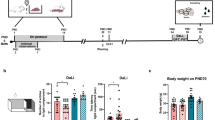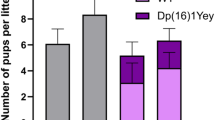Abstract
Purpose
Hypoxic insults occurring during the perinatal period remain the leading cause of permanent brain impairment. Severe cognitive and motor dysfunction, as seen in cerebral palsy, will occur in 4–10% of post-hypoxic newborns. Subtle cognitive impairment, apparent in disorders of minimal brain dysfunction will occur in > 3 million post-hypoxic newborns. Analyses of post-hypoxic rodent brains reveal reduced extracellular levels of dopamine, a key neurotransmitter of vigilance, execute function, and behavior. The purpose of this study was to assess whether synaptic levels of dopamine could be enhanced in post-hypoxic, hypodopaminergic rats.
Methods
Newborn male rats were exposed to subtle, repetitive hypoxic insults for 4–6 h per day, during postnatal days 7–11. During adolescence, we quantified dopamine content within the caudate nuclei. We then determined whether extracellular dopamine levels could be increased by injecting the psychostimulant d-amphetamine. We next assessed whether the post-hypoxic rat’s response to d-amphetamine would differentially impact place preference behavior when compared with littermate controls.
Results
Total tissue content of dopamine was significantly higher in post-hypoxic rats. Injection of d-amphetamine liberated that dopamine which subsequently enhanced extracellular levels. Post-hypoxic rats acquired conditioned place preference for d-amphetamine during the training days. During the testing day, total time spent in the amphetamine-pairing box did not differ between post-hypoxic and control littermates.
Conclusion
Postnatally occurring hypoxic insults promote remodeling of the dopaminergic system resulting in increased intracellular sequestering of this monoamine. That sequestered dopamine can be released using the psychostimulant d-amphetamine, which did not promote a conditioned place preference any greater than was observed in non-hypoxic littermate controls.



Similar content being viewed by others
References
Inder TE, Volpe JJ (2000) Mechanisms of perinatal brain injury. Semin Neonatol 5(1):3–16
Shany E et al (2017) Diffusion tensor tractography of the cerebellar peduncles in prematurely born 7-year-old children. Cerebellum 16(2):314–325
Murray AL et al (2014) Neonatal brain pathology predicts adverse attention and processing speed outcomes in very preterm and/or very low birth weight children. Neuropsychology 28(4):552–562
Row BW et al (2002) Impaired spatial learning and hyperactivity in developing rats exposed to intermittent hypoxia. Pediatr Res 52(3):449–453
Veasey SC et al (2004) Long-term intermittent hypoxia in mice: protracted hypersomnolence with oxidative injury to sleep-wake brain regions. Sleep 27(2):194–201
Decker MJ et al (2003) Episodic neonatal hypoxia evokes executive dysfunction and regionally specific alterations in markers of dopamine signaling. Neuroscience 117(2):417–425
Decker MJ et al (2005) Reduced extracellular dopamine and increased responsiveness to novelty: neurochemical and behavioral sequelae of intermittent hypoxia. Sleep 28(2):169–176
Thome J et al (2012) Biomarkers for attention-deficit/hyperactivity disorder (ADHD). A consensus report of the WFSBP task force on biological markers and the World Federation of ADHD. World J Biol Psychiatry 13(5):379–400
Rosa D (2010) Minimal brain dysfunction. In: Clauss-Ehlers CS (ed) Encyclopedia of cross-cultural school psychology. Springer US, Boston, p 626
Bradford MM (1976) A rapid and sensitive method for the quantitation of microgram quantities of protein utilizing the principle of protein-dye binding. Anal Biochem 72:248–254
Keating GL, Walker SC, Winn P (2002) An examination of the effects of bilateral excitotoxic lesions of the pedunculopontine tegmental nucleus on responding to sucrose reward. Behav Brain Res 134(1–2):217–228
Boksa P, El-Khodor BF (2003) Birth insult interacts with stress at adulthood to alter dopaminergic function in animal models: possible implications for schizophrenia and other disorders. Neurosci Biobehav Rev 27(1–2):91–101
Kohlhauser C, Mosgoeller W, Hoeger H, Lubec G, Lubec B (1999) Cholinergic, monoaminergic and glutamatergic changes following perinatal asphyxia in the rat. Cell Mol Life Sci 55:1491–1501
Pagida MA et al (2013) Vulnerability of the mesencephalic dopaminergic neurons of the human neonate to prolonged perinatal hypoxia: an immunohistochemical study of tyrosine hydroxylase expression in autopsy material. J Neuropathol Exp Neurol 72(4):337–350
Gross J et al (2000) Perinatal asphyxia induces region-specific long-term changes in mRNA levels of tyrosine hydroxylase and dopamine D1 and D2 receptors in rat brain. Mol Brain Res 79:110–117
Wang Y et al (1995) Ketamine antagonizes hypoxia-induced dopamine release in rat striatum. Brain Res 693(1–2):233–245
Oliva I, Fernandez M, Martin ED (2013) Dopamine release regulation by astrocytes during cerebral ischemia. Neurobiol Dis 58:231–241
Sarna GS et al (1990) Effect of transient cerebral ischaemia and cardiac arrest on brain extracellular dopamine and serotonin as determined by in vivo dialysis in the rat. J Neurochem 55(3):937–940
Akiyama Y et al (1991) Effects of hypoxia on the activity of the dopaminergic neuron system in the rat striatum as studied by in vivo brain microdialysis. J Neurochem 57(3):997–1002
Sulzer D, Zecca L (2000) Intraneuronal dopamine-quinone synthesis: a review. Neurotox Res 1(3):181–195
Lohr KM et al (2016) Vesicular monoamine transporter 2 (VMAT2) level regulates MPTP vulnerability and clearance of excess dopamine in mouse striatal terminals. Toxicol Sci 153(1):79–88
Yu PL et al (2015) Regulation of intermittent hypoxia on brain dopamine in amphetaminized rats. Chin J Physiol 58(4):219–227
Koob GF (1992) Dopamine, addiction, and reward. Semin Neurosci 4(2):139–148
Koob GF (1996) Hedonic valence, dopamine and motivation. Mol Psychiatry 1(3):186–189
Spanagel R, Weiss F (1999) The dopamine hypothesis of reward: past and current status. Trends Neurosci 22(11):521–527
Koob GF (2000) Neurobiology of addiction. Toward the development of new therapies. Ann N Y Acad Sci 909:170–185
Koob GF et al (2004) Neurobiological mechanisms in the transition from drug use to drug dependence. Neurosci Biobehav Rev 27(8):739–749
Koob GF, Le Moal M (2001) Drug addiction, dysregulation of reward, and allostasis. Neuropsychopharmacology 24(2):97–129
Koob GF, Volkow ND (2016) Neurobiology of addiction: a neurocircuitry analysis. Lancet Psychiatry 3(8):760–773
Cadet JL, Bisagno V, Milroy CM (2014) Neuropathology of substance use disorders. Acta Neuropathol 127(1):91–107
Spyraki C, Fibiger HC, Phillips AG (1982) Dopaminergic substrates of amphetamine-induced place preference conditioning. Brain Res 253(1–2):185–193
Kameda SR et al (2013) Opposite effects of neonatal hypoxia on acute amphetamine-induced hyperlocomotion in adult and adolescent mice. Psychiatry Res 208(1):74–77
Spear LP (2000) The adolescent brain and age-related behavioral manifestations. Neurosci Biobehav Rev 24(4):417–463
Hryhorczuk C et al (2016) Dampened mesolimbic dopamine function and signaling by saturated but not monounsaturated dietary lipids. Neuropsychopharmacology 41(3):811–821
Laplante F et al (2012) Sex differences in the effects of perinatal anoxia on dopamine function in rats. Neurosci Lett 506(1):89–93
Broderick PA, Gibson GE (1989) Dopamine and serotonin in rat striatum during in vivo hypoxic-hypoxia. Metab Brain Dis 4(2):143–153
Decker MJ, Rye DB (2002) Emerging research: Neonatal intermittent hypoxia impairs dopamine signaling and executive functioning. Sleep Breath 6(4):205–210
Acknowledgements
We dedicate this work to our beloved laboratory colleague, Inez Solomon, deceased.
Author Contributors
All authors directly participated in the study and have reviewed and approved the final manuscript.
Funding
for this study was provided through the National Institutes of Health HL-72722 (M.J.D.) and NS-36695 and NS-40221 (D.B.R.) as well as the Department of Neurology, Emory University. The sponsors had no role in the design or conduct of this research.
Author information
Authors and Affiliations
Corresponding author
Ethics declarations
Conflict of interest
The authors declare that they have no conflict of interest.
Rights and permissions
About this article
Cite this article
Decker, M.J., Jones, K.A., Keating, G.L. et al. Postnatal hypoxia evokes persistent changes within the male rat’s dopaminergic system. Sleep Breath 22, 547–554 (2018). https://doi.org/10.1007/s11325-017-1558-6
Received:
Revised:
Accepted:
Published:
Issue Date:
DOI: https://doi.org/10.1007/s11325-017-1558-6




